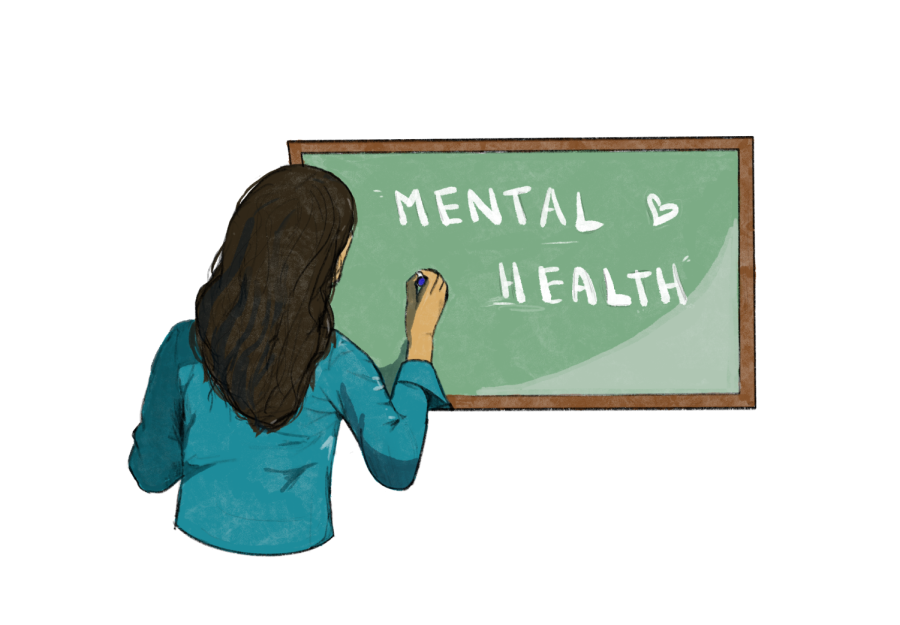FOCUS: Teachers promote mental wellness in their classrooms
Since COVID-19, many have altered their working and living environments. The past three years have seen a steady increase in mental health awareness and educators have been prioritizing student wellness. This growing mental health awareness has brought about an employment increase in emotional support staff across many educational institutions.
Compared to last year, SCHS English teacher Kate Rossner believes students are more aware of the resources on campus.
“One of the things that I’ve noticed is that students seem to be more aware of the resources that are available on campus,” Rossner said. “They seem to be more upfront and comfortable sharing concerns with teachers or me.”
While mental health awareness has been emphasized this year, special education teacher Alex Chavarria believes that there was an upward trend in mental health issues amongst students during the pandemic.
“I think the mental health aspect got a little worse for our students,” Chavarria said. “Not being able to go to classrooms, school, that social aspect, and then doing everything on the computer, I think some students were okay with that. They enjoyed that. Some students didn’t like that part of it.”
Post-distance learning, many teachers have been adapting to the new circumstances with students, considering student wellness while making classroom decisions.
In English, teachers like Rossner have focused on building small communities in their classes through feedback groups to help students feel more comfortable with collaboration.
“(It’s) so no student feels alone in class, that they have a small group of people that they really get to know, that they can get comfortable with,” Rossner said. “We believe sharing and writing is really important, but that’s not something you necessarily want to do with complete strangers.”
Other teachers, like history teacher Kyle Short, have focused on checking in with students to address mental health concerns.
“I always have some (wellness) materials posted around the classroom,” Short said. “There’s some brochures over in the bookshelf for people to take a look at, and then if I have concerns about a student, let’s say they’re sleeping a lot in class and they’re trying to check out more than they usually are, I usually send a request to the Wellness Center to say, ‘Hey, if you have time, take a look and interview the student and see what’s going on.’”
Some students, like senior Lindsay Patterson, have noticed teachers taking the initiative to relieve classroom stress.
“I’ve had teachers like Mr. Van Dyke take us out of class for a little break to walk to the garden, and I think that definitely relieves stress,” Patterson said.
Others, like junior Leila Duran, have had teachers who discuss and talk about mental health, utilizing exercises that lessen anxiety among students.
“Something that I really appreciate about (Ms. Svendsen) is that she’s very open to discussion about mental health,” Duran said. “Whenever the opportunity arises, she’ll give us – like before a test – she gives us time to breathe and do yoga exercises so that we’re calmed down and we’re not all anxiety, panic right before taking tests.”
While teachers provide a first line of response to students, they do not serve as mental health professionals the way Wellness Center staff do. Yet, Duran believes the campus lacks awareness about its resources.
“I feel like they’re not talked about enough, or… they could be more,” Duran said. “It’s just, basically, it’s just a common, peaceful place to hang out, which is nice. And they allow you to talk with counselors. But on a professional level, it’s like, it’s not gonna do much for students who are really struggling, and they’re (wellness staff) not introduced enough in class.”
For students like junior Zoe Craig, it can be difficult when booking appointments due to long waiting periods.
“I feel like it’s really hard to get an appointment,” Craig said. “When they were talking in Peer Helpers, it was like… you can’t just walk into the Wellness Center and ask for help. You need to go to the office first. You need to talk to this (person). You need to see if there’s an available slot.”
Both students and staff believe that student outreach is low in part due to the limits of the wellness staff and the amount present at Santa Clara.
“I think generally (student outreach is) just limited by the amount of staff they have in there,” Short said. “They could be doing more, but I recognize that they’re probably at capacity and they’re not able to, at current staffing, be able to do more than they can.”
Since the pandemic, the SCHS community appreciates the district’s efforts to accommodate the growing needs of students when it comes to mental health.
“I think the schools are realizing in our district that mental health is a big component to be successful at school,” Chavarria said. “(It’s) not just at school, just in life and how to deal with certain (hardships), overcome certain obstacles, just everyday life stuff. I think the school – the district’s – trying to do a better job at that, and I see it.”


